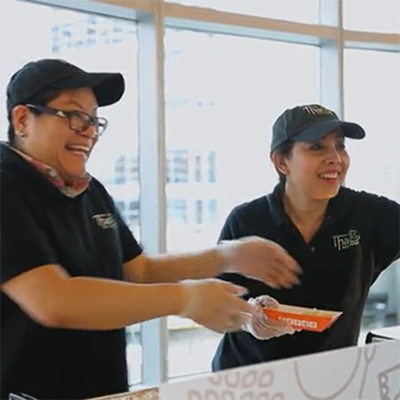
Vendor management for your corporate dining program can feel like herding cats while juggling flaming torches (and you know that’s not an exaggeration). Between coordinating multiple restaurant partners, snack vendors, chasing invoices, ensuring food quality, and making sure employees actually enjoy their meals - the administrative chaos spirals pretty fast.
And, not to stress you out more, but your employees do notice everything about their dining experience, whether they say anything to you or not. They notice when the same boring menu shows up week after week, or when food arrives cold, and they definitely can tell when the quality doesn't match what they'd get by going to the restaurant directly.
These failures ruin lunch, tank productivity, and make it even harder to get people into the office.
In this guide, we'll break down what vendor management means for corporate dining, why it matters (spoiler: it’s way more than just food!), common pitfalls, and how modern solutions make this refreshingly simple.
In corporate dining, vendor management is the strategic process of sourcing, contracting, monitoring, and maintaining relationships with food service providers to deliver consistent, high-quality meals.
It's much more involved than ordering lunch from an app! Think of it as behind-the-scenes work keeping your dining program running smoothly.
Key activities of vendor management include:
When you fully understand how the vendor management lifecycle works, it will help you approach dining strategically instead of just reactively putting out fires:

So what’s the secret to offering workplace dining that employees genuinely love? It simply comes down to vendor management.

Great vendor management affects the daily experience through food quality consistency (nothing kills morale like unpredictable mystery lunch).
Having menu variety and dietary accommodations for different needs keeps people coming back and returns on your dining program high. When employees know they can get a delicious lunch that meets their needs fast, they’ll be a lot happier and motivated during the back half of the day.

Managing food vendors can devour a whole work day’s time if you're not strategic (and we know you've got better things to do!). Good vendor management saves internal team time, reduces administrative burden by consolidating vendors, and streamlines invoicing.

Vendors should be your allies, not enemies you dread working with. Smart, automated management makes the process a breeze and can get you the best rates and quality.
But that's easier said than done, right? Thankfully, companies like Fooda will negotiate favorable pricing through volume and relationships, track spend across vendors for visibility, and identify cost-saving opportunities through regular analysis.

Organized and proactive vendor management minimizes risks through food safety and compliance, food poisoning is our arch nemesis too. Great vendors vet their suppliers and keep everyone involved safe.
Vendor management for corporate dining is not for the weak… You’re handling on a daily basis what many people do only once for holidays and one-off celebrations!
Here are the most common challenges you’ll run into when taking care of this on your own:
Now that we know the common problems that come with vendor management, let’s look at the best ways to avoid them.

Even with clear criteria, great communication, and modern technology, vendor management for corporate dining still requires significant time and expertise most companies don't have in-house.
That's why partnering with Fooda makes the most sense when implementing a workplace dining program. We manage the complexity while you focus on strategic priorities that actually move your business forward.
Plus, you still get all the benefits, rotating menu variety, dietary accommodations, local restaurant support, transparent pricing, and happy employees, without the operational headaches.
Smart companies realize that outsourcing vendor management isn't admitting defeat, it's recognizing that food service is our core competency, not yours!
Our curated network of 2,500+ local restaurants means your team doesn't spend hours researching, checking certifications, negotiating, or coordinating. Every single partner is vetted, certified, and onboarded in accordance with the department of health in that state.
You also get one point of contact for all needs. No juggling relationships, chasing invoices, or coordinating deliveries. We manage everything on your behalf (so you actually have time to get work done).
Our platform was designed in-house and eliminates the overhead companies run into when handling everything on their own.

Your employees will be impressed and satisfied when they order through the Fooda app with rotating menus, scheduling, integrated payment with automatic subsidies, rewards, and dietary filtering. On the backend, administrators get consolidated invoicing, real-time dashboards, satisfaction metrics, and predictive AI analytics.
Fooda operates without long-term contracts, aligning with the needs of the modern workplace. This is a much needed change from traditional cafeterias with their fixed, overpriced overhead that’s honestly not worth the subpar food.
Fooda offers three distinct options, ready to fulfill any of your corporate dining needs:
Popup Restaurants: Rotating local restaurants prepare food off-site and then set up on-site and serve to employees. This is ideal for offices without cafeteria infrastructure and can be set up with minimal space.
Delivery Service: Individual but consolidated delivery from local restaurants for smaller teams or hybrid schedules. We provide a consistent driver that knows your building and have a 97% on time delivery rate.
Cafeteria Solutions: Comprehensive management powered by rotating and resident local restaurants. This maintains convenience while eliminating menu fatigue.
Mix and match or switch as needs change without renegotiating or rebuilding.
Unlike traditional providers sending dollars to headquarters, if your company offers subsidies, Fooda channels them directly to the local businesses, creating meaningful impact in the community where your employees live and work.
Ready to simplify your workplace dining? Speak with a Fooda rep today and discover how easy vendor management can be!
For mid-sized companies managing corporate dining internally, vendor management can easily become a full-time role. Many workplace experience managers report spending 15-20 hours per week on dining-related tasks alone.
Traditional cafeteria buildouts take 6-12 months and significant capital investment. Modern dining solutions can launch in 2-4 weeks with minimal infrastructure. The timeline depends on your space, employee count, and whether you need on-site setup or just delivery coordination.